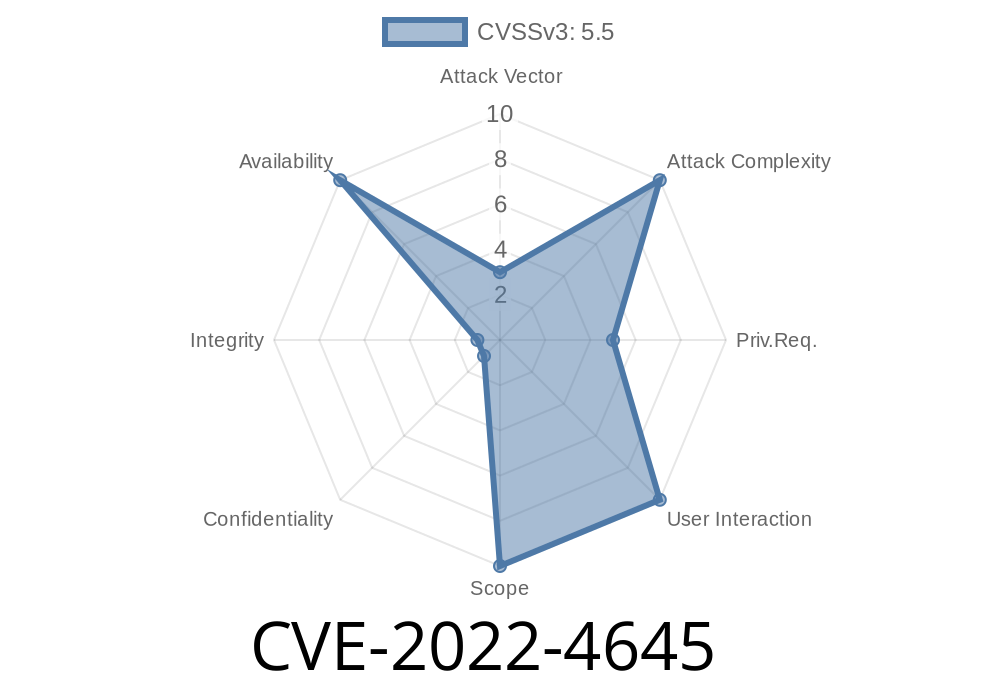In the ever-unfolding world of software vulnerabilities, file parser bugs cause especially big concern. One such issue is CVE-2022-4645, affecting LibTIFF version 4.4.. Even though LibTIFF is a powerful and widely-used library for reading and writing TIFF files, this out-of-bounds read in the tiffcp utility can let attackers crash your tools with nothing but a single crafted image. This post will break down how CVE-2022-4645 works, show you example code, link resources, and explain how you can stay safe.
What Is LibTIFF and tiffcp?
LibTIFF is a popular open source library used to read and write files in the TIFF (Tagged Image File Format) standard. Its tiffcp tool lets you merge or convert TIFF files. Because tiffcp parses input files automatically, bugs in its code can result in security risks.
Summary of CVE-2022-4645
CVE-2022-4645 describes an out-of-bounds read in the tools/tiffcp.c file of LibTIFF 4.4., specifically at line 948. By creating a specially crafted TIFF file, an attacker can trick tiffcp into reading memory it shouldn’t. This typically leads to a denial-of-service (DoS), such as crashing the tool or the process using it.
Real-world impact: If you use LibTIFF’s tools in your workflow, an attacker could send a TIFF file that crashes your system, potentially causing loss of service or opening the door for other attacks (if further vulnerabilities exist).
Where’s the Bug?
The root of CVE-2022-4645 lies in improper bounds checking when handling TIFF file data. Specifically, at line 948 in tiffcp.c, the code lacks sufficient checks to verify indexes against the actual array sizes, letting attackers manipulate file fields to cause invalid memory reads.
Here is a snippet of the affected code adapted for clarity
// Old vulnerable code (from tiffcp.c:948, LibTIFF 4.4.)
void processTIFFDir(TIFF* tif, uint16 *indices, uint16 count) {
for (uint16 i = ; i < count; i++) {
// ... other code ...
uint16 idx = indices[i];
// Use idx without checking if it's in bound
// This can cause an out-of-bounds read
doSomethingWith(idx);
}
}
What's missing?
A check to make sure idx (and i) don’t run past the size of the indices array. If the file sets count to a maliciously large value, reading indices[i] can read outside the buffer—causing undefined behavior or a crash.
How Could an Attacker Use This?
Malicious users can craft a TIFF file with fields that cause tiffcp to parse arrays past their intended end. By feeding such an image to tiffcp, the tool will read memory outside its buffer—usually resulting in a segmentation fault (DoS).
Example usage:
Suppose someone sends this TIFF to a system that automatically processes incoming files (for example, a web service that generates PDFs from TIFFs). That service could be taken down by a simple file upload.
Can I See an Example Exploit?
While releasing a fully weaponized TIFF is beyond the scope of this post, here’s some pseudo-code showing how basic fuzzing can crash the vulnerable version:
# This will fuzz tiffcp and potentially crash it if you have a vulnerable build
afl-fuzz -i in_dir -o out_dir -- tiffcp @@ output.tiff
Or, using a Python PoC to create a malformed TIFF header (conceptual)
# pseudo-code to create a TIFF file with broken indices
with open("exploit.tiff", "wb") as f:
f.write(b"II*\x00") # TIFF header
f.write(b"...") # minimal structures
# Overwrite count field to a very large number
f.write(b"\xff\xff") # Malicious count (overflows)
# Add minimal indices array, rest of reads go out-of-bounds
f.write(b"\x01\x00") # only one index, but count says xffff
# ... further structure
When the above file is fed to tiffcp exploit.tiff output.tiff, it may crash due to out-of-bounds reads.
How Was It Fixed?
The fix, commit e8131125, adds necessary checks to ensure array accesses stay within bounds.
Example fixed code
// Fixed code with bounds check
void processTIFFDir(TIFF* tif, uint16 *indices, uint16 count, uint16 size) {
for (uint16 i = ; i < count; i++) {
if (i >= size) break; // Don't read beyond array
uint16 idx = indices[i];
// process idx safely
}
}
If you build LibTIFF from source, apply commit e8131125 or upgrade to a newer release (4.5. or later).
Recommendations
Are you vulnerable?
- If you use tiffcp or any software statically or dynamically linking LibTIFF 4.4., and accept TIFF files from untrusted sources, you are at risk.
How to defend:
Update LibTIFF to 4.5. or later.
- If building from source, apply commit e8131125.
References & Further Reading
- CVE-2022-4645 at NVD
- LibTIFF Commit e8131125 (the fix)
- LibTIFF Official Website
- tiffcp source code
Conclusion
CVE-2022-4645 is a classic “just one check missing” memory bug: easy to overlook, but potentially serious if you rely on LibTIFF in any tool chain. If your software handles images on untrusted input, apply the fix or upgrade LibTIFF now. Don’t let a crafted TIFF take down your applications! Stay safe and keep your dependencies up to date.
*Feel free to reach out if you have questions about protecting your image pipeline from similar bugs!*
Timeline
Published on: 03/03/2023 16:15:00 UTC
Last modified on: 03/31/2023 11:15:00 UTC
